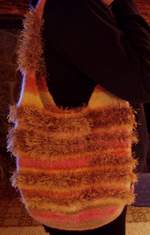I’ve blogged about crochet and felting before. With the advent of cold weather in my part of the world, I began thinking about making some items for my mother in law who’s visiting us until late November. She’s not used to cold weather and will need some layers to keep her warm. Felted wool is some of the warmest fabric around. Actually wool felt is a wonder fabric. Why?
It’s waterproof if it’s heavily felted….
It’s almost fireproof – with a flash point higher than 100 degrees F….
It has no noticeable nap….
It can be cut and will not ravel, making it an excellent choice for garments, bags, and other cold weather items…
It’s easy to make!
Here’s a sample of a decorative felted bag:

http://www.woolcrafting.com/felted-crochet-bag-pattern.html
Now, having written all that about felting in the paragraphs above, it’s obvious that part of this bag is NOT felted. How?
Wool that has not been superwashed or bleached WILL always felt if certain things happen to it:
application of heat, water, soap, and agitation (and heat isn’t absolutely required).
BUT, one can crochet an item, like the purse above, with rows of 100% feltable wool and with rows of non-feltable fibers like fun-fur, acrylic, viscose, and other novelty yarns and fibers. The application of heat, water, soap, and agitation may do something to these other fibers, but they won’t felt.
What is felting? Properly called ‘fulling’, it’s the meshing together of teensy barbs on the strands of wool that are crocheted (or knitted or woven). Actual, even if the strands aren’t worked into any sort of pattern, they’ll felt if the conditions are right.
Creating felted or fulled items requires a little preplanning. First, they must be crocheted about 1/3 larger than the expected dimensions of the finished item. To assure this, one must create a swatch using the intended wool (or wool blend) and treat it with heat, water, soap, and agitation like the final object will be treated.
There are plenty of patterns online and in books and magazines for felted (or fulled) crochet items. Two great sources online are:
www.crochetpatterncentral.com
www.lionbrand.com
If you have some unbanded wool on hand and want to know if it will felt, use the swatch method to test it. Anything labeled ’superwashed’, as is often the case for sock yarns and baby yarns, will not felt no matter how hard you try. Also, white yarns are often hard or impossible to felt because they have been bleached. Still, I have had success using ‘white’ yarns for contrast, sticking with natural ‘whites’ and off-whites that haven’t been bleached. Only way to be sure is to test swatch the wool.
Crocheted felted items also combine nicely with other crafts. Appliques made from flat felt lengths (which you can purchase or create yourself) will add great dimension to store bought sweaters and denim jackets. Felted flowers make great appliques. Geometric shapes make handy, inexpensive, and durable patches for kids’ jeans and sweats. How about putting your kid’s name on a sweatshirt, ball cap or backpack with felt? It can be sewn on or glued on with washable fabric glue. The uses are many. Go out and make something!